The arrival of the omicron variant has led some politicians and public health grandees to call for a return to business closures and ‘circuit-breaker’ lockdowns.
The variant has been found worldwide, including in the US and the UK. The variant has already surpassed delta – dominant before omicron – in the UK.
Early reports from South Africa confirm that the variant is more transmissible but produces a milder disease, with a lower chance of hospitalization and death upon infection.
My message is this: we can’t stop the spread of COVID, but we can end the pandemic.
In October 2020, I wrote the Great Barrington Declaration (GBD) along with Prof. Sunetra Gupta of Oxford University and Prof. Martin Kulldorff of Harvard University.
The centerpiece of the declaration is a call for increased focused protection of the vulnerable older population, who are more than a thousand times more likely to die from COVID infection than the young.
We can protect the vulnerable without harming the rest of the population.
As I stated above, we do not have any technology that can stop viral spread.
While excellent vaccines protect the vaccinated versus hospitalization or death if infected, they provide only temporary and marginal protection versus infection and disease transmission after the second dose.
The same is likely true for booster shots, which use the same technology as the initial doses.
What about lockdowns?
It is now abundantly clear that they have failed to contain the virus while wreaking enormous collateral damage worldwide.
The simplistic allure of lockdowns is that we can break the chain of viral transmission by staying apart.
Only the laptop class — those who can just as easily work from home as in the office — can abide by a lockdown in actual practice, and even they have trouble.
Essential workers who keep society going cannot afford the luxury, so the disease will keep spreading.
Will the same policies that failed against a more virulent strain succeed in containing a more transmissible strain?
The answer is self-evidently no.
The harms of lockdown on children and the non-elderly are catastrophic, including worse physical and mental health and irretrievably lost life opportunities.
Lockdowns imposed in rich countries mean starvation, poverty, and death for the residents of poor countries.
There is, however, a good alternative to lockdown.
The Great Barrington Declaration (GBD) calls for a return to normal life for low-risk children and non-elderly adults.
The principles at the heart of the GBD are as important today as they were a year ago.
In fact, they are more important now because we now have technological tools that make focused protection of the vulnerable much more straightforward than it was a year ago.
First and most importantly, the vaccine.
Because unvaccinated older people face such a high risk for a poor outcome on infection, and because the vaccine is so effective at blunting severe disease and death, vaccinating older people is the top priority if life-saving is to be the top priority.
However, the vast majority of unvaccinated older people live in poor countries.
At current rates, the worldwide vaccination campaign will not be complete until the end of 2022, too late to save countless vulnerable people.
Prioritizing those who have never previously had COVID will help preserve doses for those who would most benefit since – like the vaccine — COVID recovery provides excellent protection against future severe disease.
Booster shots for older people also make sense.
But to preserve doses, they should be reserved for those who have not previously had COVID and were vaccinated more than 6 to 8 months ago.
According to a careful study conducted by Swedish scientists, vaccine efficacy versus severe disease also starts to wane around that point, so boosting before then does not provide a substantial benefit.
Second, we should make available effective early treatment options.
During Florida’s summer wave, Gov. Ron DeSantis promoted the use of monoclonal antibodies – an FDA-approved treatment – by patients early in the course of the disease, an action that saved many lives.
Safe and inexpensive supplements like Vitamin D have been shown effective. Promising new treatments from Pfizer and a new antibody treatment for the immunocompromised by Astra Zeneca promise to become more widely available. Until that happens, they should be preserved for use by the most vulnerable when sick.
Third, the widespread availability of inexpensive, privately conducted, rapid antigen tests in the UK has empowered everyone to make wise choices that reduce the risk of infecting vulnerable people. So far, the FDA says that these tests work to detect omicron.
Even if you have no COVID-like symptoms, these tests accurately read whether you harbor the virus and pose a risk of spreading it to close contacts. With this test in hand, anyone can check if it is safe to visit grandma before heading over to her care home. It is a perfect tool for focused protection of the vulnerable.
US COVID policy should focus on making these tests cheaper and more widely available, as they are in the UK.
Finally, since the virus very often spreads via aerosolization events, upgrades to ventilation systems in public spaces will reduce the risk of older people participating in everyday social life outside the home.
It is no accident that COVID disease spread is so rare on airplanes since they are all outfitted with excellent air filtration systems. Upgrading other public facilities, such as other public transportation systems, would reduce the risk of infection for the vulnerable.
There are some hopeful signs that the political and ideological winds are shifting, while other developments signal a return to failed strategies.
Colorado’s Democrat Governor Jared Polis recently declared that the widespread availability of vaccines spells ‘the end of the medical emergency,’ and he is resisting calls to impose new statewide mask mandates.
Yet on the coasts, in California and New York, elected officials are renewing mask requirements for all – regardless of health or vaccination status.
The end of the pandemic is primarily a social and political decision.
Since we have no technology to eradicate the virus, we must learn to live with it. The fear-based lockdown policies of the past two years are no template for a healthy society.
The good news is that with the new and effective technologies available and the focused protection ideas outlined in the GBD, we can end the pandemic if only we can muster the courage and political will to do so.
In Sweden and many US states that have eschewed lockdowns, the pandemic is effectively over, even as the virus continues to circulate.
As normal society resumes, the vast majority will find that living with the virus is not so hard after all.
First published in the Daily Mail.
Join the conversation:


Published under a Creative Commons Attribution 4.0 International License
For reprints, please set the canonical link back to the original Brownstone Institute Article and Author.









